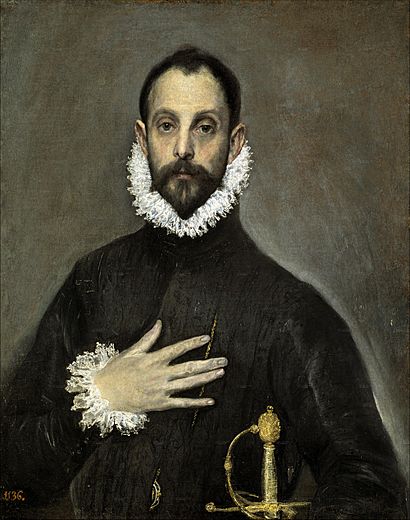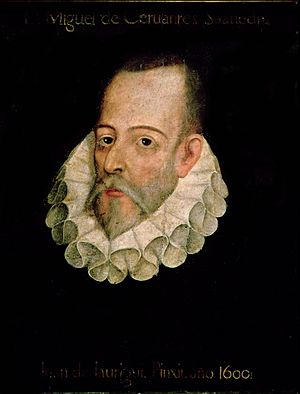The Nobleman with his Hand on his Chest facts for kids
Quick facts for kids The Nobleman with his Hand on his Chest |
|
|---|---|
| Spanish: El caballero de la mano en el pecho | |
 |
|
| Artist | El Greco |
| Year | c. 1580 |
| Medium | Oil on canvas |
| Dimensions | 81.8 cm × 65.8 cm (32.2 in × 25.9 in) |
| Location | Museo del Prado, Madrid |

The Nobleman with his Hand on his Chest is a famous oil painting by the artist El Greco. It is one of the first artworks he painted after moving to Spain.
This painting was created around 1580 in Toledo. Today, you can see it at the Museo del Prado in Madrid. It is the most well-known of several portraits El Greco painted of unknown gentlemen. All these men wear black clothes and white ruffs (a type of collar). They are shown against a dark background.
Contents
What is This Painting About?
This artwork shows a nobleman dressed in black. He has a white ruff around his neck. His right hand is placed on his chest. This gesture might mean he is taking an oath or making a promise.
The painting is a "secular portrait." This means it shows a regular person, not a religious figure. El Greco painted many religious scenes, but he also painted important people of his time.
Who is the Man in the Painting?
For a long time, people have wondered who the man in this painting is. We don't know for sure, and there are a few ideas.
Some art experts think it might be Juan de Silva y de Ribera. He was the 3rd Marquis of Montemayor. He was also a military commander of the Alcazar of Toledo. This was an important job in Toledo. His hand gesture could show him taking an official oath for his role.
Could it be Cervantes?
Another interesting idea is that the man might be Miguel de Cervantes. He was a famous Spanish writer. He wrote the book Don Quixote.
There are a few reasons why some people think it could be Cervantes:
- Cervantes was around the same age as the man in the painting when it was made.
- The man's left hand is hidden. Cervantes lost the use of his left arm in a battle called the Battle of Lepanto.
- Some people think the man looks like other portraits of Cervantes, like the one by Juan de Jáuregui.
Is it a Self-Portrait?
A few artists and historians also think the painting could be a self-portrait of El Greco himself. This means he painted his own face. It's a fun idea to imagine the artist looking back at us from his own work!
No matter who the man is, this painting is one of El Greco's most famous works. It helps us understand the style of portraits from that time.
See also
 In Spanish: El caballero de la mano en el pecho para niños
In Spanish: El caballero de la mano en el pecho para niños

